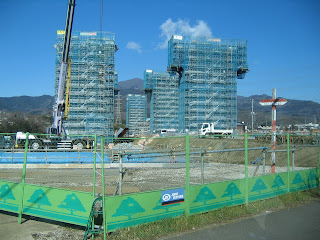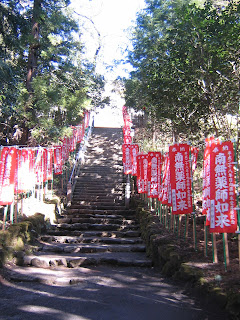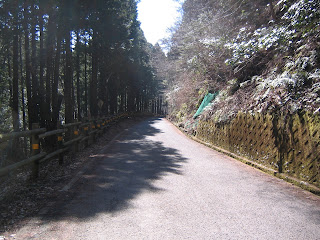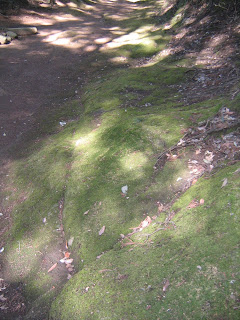This week, I tell you my visit to the 2 old temples at the foot of Mt. Oyama. First, the access. These days, Tokyonites normally visit Mt. Oyama not walking from Tokyo, but by Odakyu Odawara Line 小田急小田原線 from Shinjuku 新宿. Especially, if you plan to visit 3 old temples, Hinata Yakushi Temple 日向薬師, Sekiunji Temple 石雲寺, and Oyama Temple 大山寺, that have been a part of Mt. Oyama Pilgrimage for ages, the nearest station to get off is Isehara 伊勢原駅. We take Kanachu Bus 神奈中バス from there to terminal stops, and then walk for a while to the destination. Of course, you can drive by leaving Tomei Expressway either at Atsugi IC or Hatano-Nakai IC, and join Route 246 for Oyama Route. The problem of this approach comes from the fact that the choice of trekking roads is limited for Mt. Oyama. When you plan a day-hike in addition to visiting temples, you have to return to the temple’s parking lot using the same road for coming and going in your itinerary. On the other hand, if your intention is not hiking but only visiting these temples, the parking is relatively easy. So, at the end of the posts, I write the addresses of the temples for your driving. Your car navigation system would do the conductor with this info.
Hinatayakushi and Sekiunji are neighbors sharing the same bus stop, Hinata Yakushi Terminal Stop 日向薬師(終点). To go there, take Kanachu Bus I-20 伊20, I-22 伊22 or I-24 伊24 from the Terminal #3 in the North Exit of Isehara Station. (Time Table, here.) It’s a less than 25 minutes bus ride, first through the town of Isehara around Route 246, passing the athletic fieldsof Senshu University 専修大学, and entering a rural community of Hinata日向. Before reaching to the Senshu U’s baseball ground, we encounter a huge construction site for the Daini Tomei Expressway (the Second Tomei) 第二東名 which is coming from Toyota City 豊田市 (Toyota-Higashi 豊田東 JCT) and currently reaching to Gotemba City 御殿場市 (Gotemba 御殿場 JCT) at the foot of Mt Fuji. The plan is, the route threads through the surface of deep Tanzawa Mountains and joins with the “First” Tomei Expressway around this structure we can see from the bus to Hinata Yakushi … Among the trainees for Kanagawa Forest Instructor, the project conjures up a mixed feeling. We know a gigantic flyover near Tanzawa Lake 丹沢湖, just before Tsuburano Tunnel 都夫良野トンネル of Tomei Expressway, where it is always congested. In weekends, the menacing exhausts of Harley-Davidsons echo within the otherwise quiet West Tanzawa … Daini Tomei would do the same for the East Tanzawa around Mt. Oyama. “Well, at least drivers can enjoy the scenery of Tanzawa, can’t they?” “Yeah ...”
 |
| The #3 bus stop for North Exit of Isehara Station |
 |
| Building an expressway … I tell you, they are HUGE. |
The bus route between Senshu U Field and Hinata Yakushi has a unique system 降車自由バス. Although they have bus stops with name, if you ask the driver in a reasonable way, you can stop the bus wherever you want to along the route. When we enter the Hinata area, we could guess the reason of the special service … the community of Hinata looks very rural AND elderly. Japan is an aging country where giving up driving licenses is encouraged by the police and the government. But, if the grandpas or grandmas in Hinata community give up their license, while the public transportation forces them to walk a long way from a bus stop, it would be THE problem ... Soon, the bus arrives at Hinata Yakushi terminal stop. No Kombini, or supermarket. A tiny concession store selling sweets and bottled waters greets us. Welcome to one of the spiritual spaces of Mt. Oyama!
 |
| Hinatayakushi terminal stop |
 |
| You
can buy drinks for your hike at a tiny concession store next to the stop. |
 |
| The
toilet here is superb! With the fully equipped washlets, with soft toilet papers, and clean washstands with soaps. |
From the bus terminal let’s walk back a bit along the bus route to find stone gateposts on the left, which is the sign of the road leading us to Hinata Yakushi Temple. It’s about 15-20 minutes’ walk from here to the main hall of the Temple, climbing up an ancient mountain road. The institution’s official name is Hojohboh 宝城坊 established by abbot Gyoki 行基 in AD716. This priest was an avant-garde by spreading the temple knowledge for civil engineering among the ordinary villagers. First, the government was skeptical of his way of religious activity, but later realized he was the guy for implementing their development policies. Finally, in 740 Emperor Shomu 聖武天皇 made him the officer in charge of the construction of Todaiji Temple 東大寺 that was the central institution of Japanese Buddhism. So, the rich and powerful in later period regarded Hinata Yakushi very highly. Among them was the couple of Minamoto no Yoritomo 源頼朝 and Masako 政子 who started Kamakura Shogunate Government 鎌倉幕府 in 1192. They patronized Hojohboh before they occupied the office of Shogun 将軍, which made the “power” of Hinata Yakushi all the more “apparent.” The Temple completed the third repair of their Main Hall last November using the same methodology employed during the previous two reparations in 1380 and 1660. Since traditional technique to build Japanese shrines and temples does not use nails, but employs Lego’s way, it is possible to recycle original timbers many times as long as they are robust enough. (More to this, when we visit Sekiunji Temple.)
 |
| 20m
from the bus stop, there is the sign post showing us … |
 |
| these
gateposts. Just go ahead ... |
 |
| to climb the steps and … |
 |
| reach to the main gate of the Hinata Yakushi. |
 |
| The
main gate has the early 19th century images of A-hūm. |
 |
| From
there, we climb up wide but mountainous trekking road which has a legend of Minamoto no Yoritomo who passed this road in shining outfit on superb horse with handsome samurai acolytes … movie, movie. |
 |
| Nearly there … |
 |
| Recently
repaired Main Hall for Hinata Yakushi. I love their thatched roof in modest but elegant line, surrounded by beautiful vegetation. That’s the sanctuary in the forest. |
The Temple is dedicated to Bhaisajyaguru 薬師如来 in the image by hatchet curving of the 10-11th century. The statue is registered as a National Important Cultural Property 国重要文化財, and stored in a special cabinet whose door is opened to the public only for 1-3 January, 8 January (the first day of Bhaisajyaguru 初薬師), and April 15. The Treasure Warehouse 宝物殿 of the Temple keeps the cabinet and the other 12th-18th centuries’ icons also registered as National Important Cultural Properties. If you want to see them (except the Bhaisajyaguru) in the Treasure Warehouse, you ask the temple people to open the key of the Warehouse and pay 300 yen for adult admission. And here is THE manner to admire old wooden sculptures in Japan: no photos please as they are very fragile. They are intentionally kept in dark and cool places for preservation. Strong flash light should damage our national heritages. The Temple also has a 14th century bell whose copper was originally donated by Emperor Murakami 村上天皇 in 952. It is also in the list of National Important Cultural Properties.
 |
| The belfry for the bell. Could you see that magnificent cedar tree next to the graceful structure? The notice in front of the tree says botanists estimate it is at least 800 years old. |
 |
| Next to the belfry, there is a small shrine for Ākāśagarbha 虚空蔵菩薩. This tree is alive! |
On April 15th you can see a millennium old image of Bhaisajyaguru together with the other treasures of the Temple. Moreover, on that day, the institution has a unique festival that allows us to peek into the Japanese mountain religion. Many Yamabushi 山伏, the priests of mountain worship, annually gather at Hinata Yakushi on April 15 and perform in public their full-day ritual such as fire-walking and acrobatic tree climbing called Shiki-nobori 神木のぼり. The Temple has a parking space at the back of the Treasure Hall that can be accessed either from the bus-route, or from Nanasawa 七沢 of Atsugi City 厚木市 where the campus of Kanagawa Nature Conservation Center 神奈川県自然環境保全センター locates.
 |
| In the back of Treasure
Warehouse, they have small picnic space and toilet. |
For the next temple, you can either go back to the bus stop, or follow a paved forest road running at the back of the Treasure Hall down to the road continuing from the Hinata Yakushi stop ... there is a trekking road beyond the plum orchard going to the same direction, but the latest map published by Shobunsha 昭文社 says the route is rarely used so that it won’t be safe. Never underestimate the danger of Tanzawa; it’s easy to lose the way. Anyway, the road we came by bus continues as a forest road along a mountain stream named Hinata River 日向川, and ends at a summer camping site of Hinata managed by Isehara City. Beyond the camping space, cars without permit cannot enter. Actually, from the bus terminal to the west, including Hinata Yakushi, is in Tanzawa Quasi-National Park 丹沢国定公園. Japanese national parks were established in 1931 after 2 professors of Tokyo University, Dr. Kuroita Katsumi 黒板勝美 and Dr.Miyoshi Manabu 三好学, introduced Japanese public European system of commemorating cultural and natural heritages. Its original idea emphasized more on the “recreational use of heritages to improve the health of general public,” which differs from the primary stress on “conservation” for the US national park. Thus, we meet several private tourism business such as BBQ gardens and secluded area for mountain stream fishing. Cation: although Hinata River is rich in freshwater fishes such as trout and sweetfish, you must have license to catch them. Otherwise, you’ll be charged with theft. We are greeted by the signs of tourism facilities in the forest for half an hour, and then, there comes the gate for Sekiunji Temple 石雲寺.
 |
| The
forest road goes down from Hinata Yakushi Temple to another forest road coming from the bus terminal. |
 |
| Along
the way we first meet Johatsuganji Temple 浄発願寺 which was moved in 1938 from the upstream of
Hinata River after debris-avalanche caused by a typhoon. Here is another evidence of fragile soil in Tanzawa … The temple was established in 1608 as a branch temple of Kan’eiji Temple 寛永寺 in Ueno 上野, Tokyo. It was famous as a sanctuary for male criminals who did not commit murder or arson. They worked in road construction in Tanzawa for atonement, but were not confined in jail. |
 |
| Anyway,
go ahead. To the left is a dead end with another summer camping site + “reportedly, the tomb of Prince Otomo.” ??? More to it, below. |
 |
| The
banner says, “A temporary license for fishing is sold here.” |
 |
| “To
use this BBQ site, please call Hinata Mountain Villa 日向山荘.” |
 |
| The
gate for Sekiunji Temple. The parking is next to this gate. |
It is said that Sekiunji Temple was established in 718, but a remaining written record shows a monk Tenkei Souon 天渓宗恩 started the current temple for Zen Buddhism (Soto Zen 曹洞禅) in 1489. According to the original legend, in 718 a monk Kegon Myotan 華厳妙瑞 traveled deep in the mountain around here, and meditated on a rock near the stream. Suddenly over there a mist of noble mauve appeared. He went to the riverbed, and saw lilac vapor hovering above a 10m wide rock. He was awe-struck and chanted intensely the name of Buddha and Maitreya. Suddenly, the saints and Buddha appeared within the cloud. The monk wondered the meaning of this, and asked locals if they had any idea. They said Prince Otomo 大友皇子 who was the Crown Prince of Emperor Tenchi 天智天皇 and defeated by his uncle, Emperor Ten’mu 天武天皇, during the Civil War 壬申の乱, escaped from Nara 奈良 with his followers to Hinata near Mt. Oyama. The Prince suffered the trauma from the battle and died, and his acolytes killed themselves after the death of their master. Kegon Myotan sympathized with the royal tragedy, and planted a seedling of a pine tree at the place where Prince Otomo and his followers buried. About 500 years later, a family who was said to be the descendants of one of the devotees of the Prince built a quintuple tower with stone, and in 1489 Tenkei Souon made the place as a full-fledged temple ... I doubt the Prince thing. The battle ground was in Nara Prefecture, a bit far away from here. But the whole story is very Tanzawa. Well, if you are a self-respecting follower of spirituality, you should meditate on the rock near Mt. Oyama. If it yields a purple haze, being Jimi Hendrix or not, you may have been doped, or really reached to the world of Buddha … Oh, my Buddha, what am I saying???
 |
| Reportedly, the tomb of Prince Otomo |
So we can expect some sort of mystical experience by entering the gate of Sekiunji Temple … unfortunately, at the moment, the institution is engaging in their turn for the repair of ancient structure. Their Main Hall is surrounded by scaffolding. The meditation rock and the quintuple tower appeared in the legend, both of which are supposed to be in front of the Main Hall, are within the piles of construction materials. … Quiet meditation would be difficult now … Rather, I had an excitement. For a 21st century repair of Japanese traditional wooden buildings, the experts jack up the entire edifice to replace weakened joists and other foundations with new timbers. When I’ve been Sekiunji Temple, they were doing just that! The operation was done by a machine. A team of engineers called each other to move the massive Hall, and the structure was squeaking with impressively low and dry noise of motor and woods. “Pilar #1, Ready!” “Pilar #2, Ready!” “Pilar # …!” Clunk, Clunk, Creeeeeak, Biff! Woooooooow. The color of the haze was … inevitably dusty brown. Er, well, we’ve returned to a gigantic construction site of the 21st century, haven’t we?
 |
| Up, up, up … |
 |
| It’s
the place supposed to be for meditation with purple haze. |
Next week, I plan to report about Yokohama 2017 Garden Necklace, which occurs in my neighborhood. Then, my adventure around Oyama Temple will follow in 2 weeks' time. That’s proudly a tourist town in the forest of Kanagawa!
Hinata Yakushi Temple 日向薬師宝城坊
1644 Hinata, Isehara City,
259-1101 伊勢原市日向1644
(phone) 0463-95-1416
Sekiunji Temple 石雲寺
1767 Hinata, Isehara City,
259-1101 伊勢原市日向1767
(phone) 0463-95-4582
http://sekiunji.sakura.ne.jp/



No comments:
Post a Comment